fees waived
Diagnostic Radiography, MDRad (Hons)
Queen Margaret University, United Kingdom
Ranking in UK
Radiography
Health Professions
Costs
food & rent S$17.1K / year
Entry requirements
Scholarships
6 available
11 - 20 available
More than 50 available
Limited quantity
Information
Code
Intakes
Website (External)
Programmes
Information
Duration
2029
This four-year undergraduate Master of Radiography: Diagnostic (MDRad) or BSc (Hons) Radiography: Diagnostic course provides the theoretical knowledge and practical skills essential for a career as a Diagnostic Radiographer. It integrates practice placements to apply learning in real clinical settings. All students start on the master’s pathway, with options to diverge to the BSc route after the second year; both pathways lead to eligibility for registration with the Health and Care Professions Council (HCPC).At QMU, students benefit from a supportive learning environment, strong clinical placement arrangements, and advanced facilities like high-tech imaging suites. The course is accredited by the Society and College of Radiographers and HCPC, ensuring graduates are well-prepared for employment with excellent communication skills and interprofessional expertise. Assessments include exams, assignments, and placements across Scotland to build confidence and clinical knowledge.
Year 1: Anatomy and Physiology/Becoming and Allied Health Professional/ Developing Resilience of Self and Others Introduction to Diagnostic Practice, Diagnostic Practice 1/Finding your Academic Voice Year 2: Behaviour Change/Developing a Spirit of Inquiry/Cross Sectional Imaging Science/Diagnostic Practice 2/ Diagnostic Imaging Placement A Year 3: Active Citizenship/Health Literacy/ Specialist Imaging and Advancing Diagnostic Practice/Theoretical and Clinical Approaches to Multidisciplinary Team Working/Understanding and Appraising the Evidence for Practice/ Diagnostic Imaging Placement B Year 4: Applying Skills of Critical Enquiry/ Evidence Informed Practice/ Leadership and Enterprise in Healthcare/Preliminary Clinical Evaluation/Diagnostic Imaging Placement C The modules listed here are correct at time of posting (Feb 2024) but may differ slightly to those offered in 2025. Please check our website for an up to date list of modules.
A local representative of Queen Margaret University in Singapore is available online to assist you with enquiries about this course.

